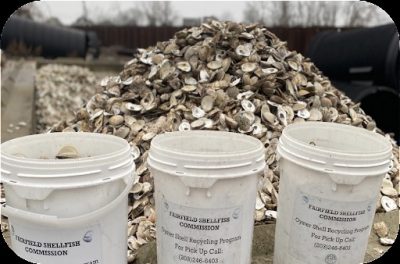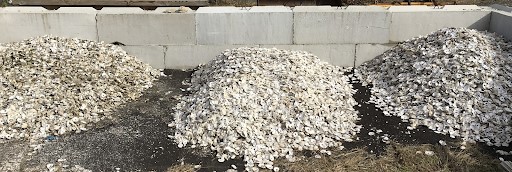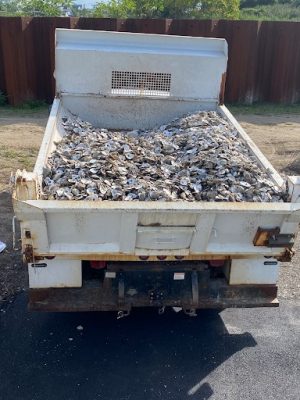
Empty oyster and clam shells from Long Island Sound shouldn’t be treated like trash.
They are vital components of healthy habitat for shellfish and other marine life, and need to be returned to their watery home instead of being hauled away with other garbage. That’s the message shell recycling advocates are advancing as part of a new statewide initiative.
“Virtually all the shell that goes to restaurants and markets is being discarded,” said Tessa Getchis, aquaculture extension specialist for CT Sea Grant and UConn Extension. “Connecticut is in the rare position of having some of the few self-sustaining populations of oyster beds in the world. We need to get that shell back in the water so that healthy beds remain productive, and so we can rebuild those in suboptimal condition.”
At 7:30 p.m. on April 4, Getchis will give a presentation on the history of the Connecticut oyster beds and the state’s efforts to restore this critical habitat, and UConn Marine Sciences Professor Zofia Baumann will follow with an overview of her efforts to develop a shell recycling program in the town of Groton. The shell recycling initiative is being launched as part of a broader effort to restore the state’s natural shellfish beds to preserve and enhance their vital economic, environmental and cultural contributions.
The program at the UConn Avery Point campus, titled, “Ensuring the Future Viability of Connecticut’s Natural Oyster Beds,” is part of the annual Coastal Perspectives public lecture series held in the campus auditorium. Admission is free, and the program can also be accessed virtually.
“Connecticut’s oyster beds throughout Long Island Sound are among the few remaining sustainable oyster habitats in the world, providing a varied range of ecosystem services benefiting the

state’s environment, economy and culture,” said Bryan P. Hurlburt, Connecticut Department of Agriculture commissioner. “Oyster shell recycling is identified as a priority action to support restoration of oyster habitats which in turn improves water quality, provides habitat for marine life and shoreline protection. Recycling shells is key to our ability to get the job done.”
During the presentation, Getchis will introduce Michael Gilman, who was asked in January to serve as the state’s shell recycling coordinator. An aquaculture extension assistant for CT Sea Grant, Gilman is working with towns interested in the voluntary program.
“We want to help towns get the ball rolling on the infrastructure that will be needed,” Gilman said.

Gilman notes that there is a very successful grassroots shell recycling program in Fairfield. As an outgrowth of that, Timothy Macklin, vice chairman of the Fairfield Shellfish Commission, is creating a non-profit organization that will serve as a resource for towns that do not currently have capacity to develop their own program.
“We want to make everyone aware of Fairfield’s program, because it works,” Gilman said. “But there are many different models. Together, we’re exploring all the possibilities.”
CT Sea Grant is working closely with the Connecticut Department of Agriculture (CT DoAG), the shellfish industry and other partners such as the CT Restaurant Association to better understand how they can divert shells from the food waste stream. A survey distributed this month will gather feedback from food service establishments—gauging their interest, motivation and obstacles with respect to shell recycling. Another important effort being led by Alissa Dragan, supervising environmental analyst at the DoAG Aquaculture Bureau, is the creation of regulatory guidance for restaurants, towns and markets to follow in collecting, sorting and storing the shell properly. After several months of outdoor storage, the shell would ultimately be returned to natural shellfish beds, some of which are also a major source of seed oysters for the state’s aquaculture industry. It would not be diverted for use on driveways and other landscaping uses.
Returning shell to the water is essential to support the ecosystem services that oysters provide, and for the long-term sustainability of commercial and recreational shellfishing in the Sound, Getchis emphasized. The public is cautioned, however, not to independently place shell in the water since that could create serious negative impacts if the shell is not cured or placed properly.
For information on joining the April 4 program virtually, and about other talks in the Coastal Perspective series, visit: https://marinesciences.uconn.edu/lectures/. The Coastal Perspectives lectures are sponsored by Connecticut Sea Grant College Program, UConn Department of Marine Sciences, UConn Maritime Studies Program and the UConn Avery Point Campus Director’s Office.
For more information about shell recycling, contact Tessa Getchis or Michael Gilman.